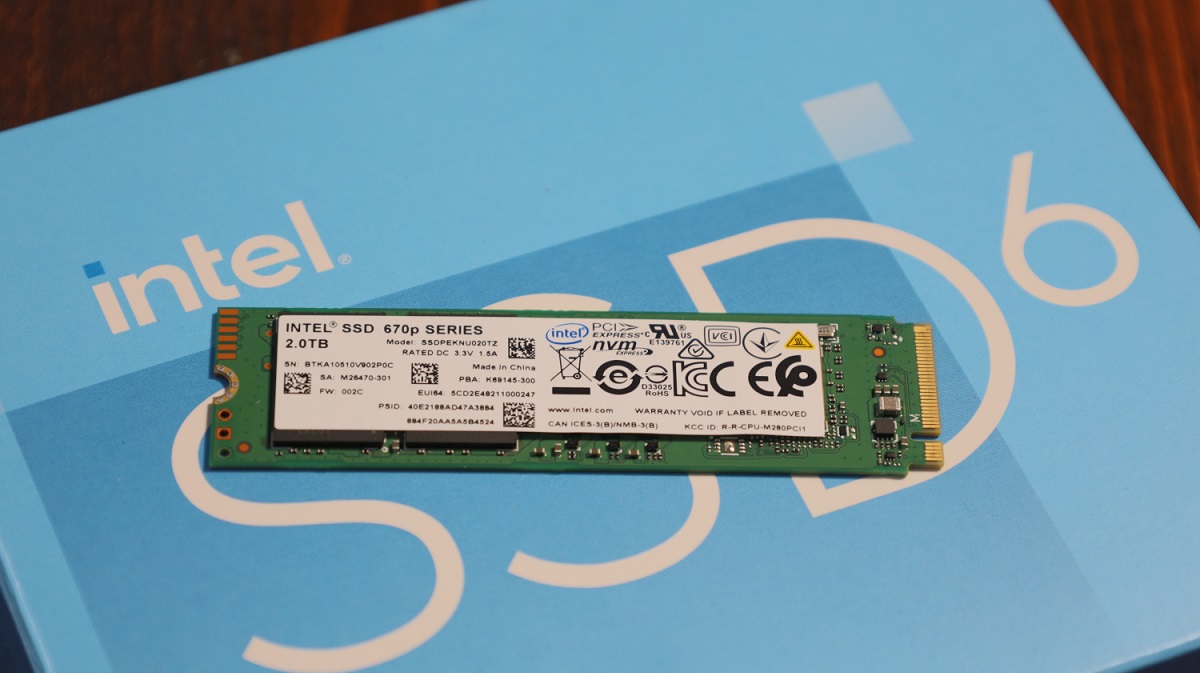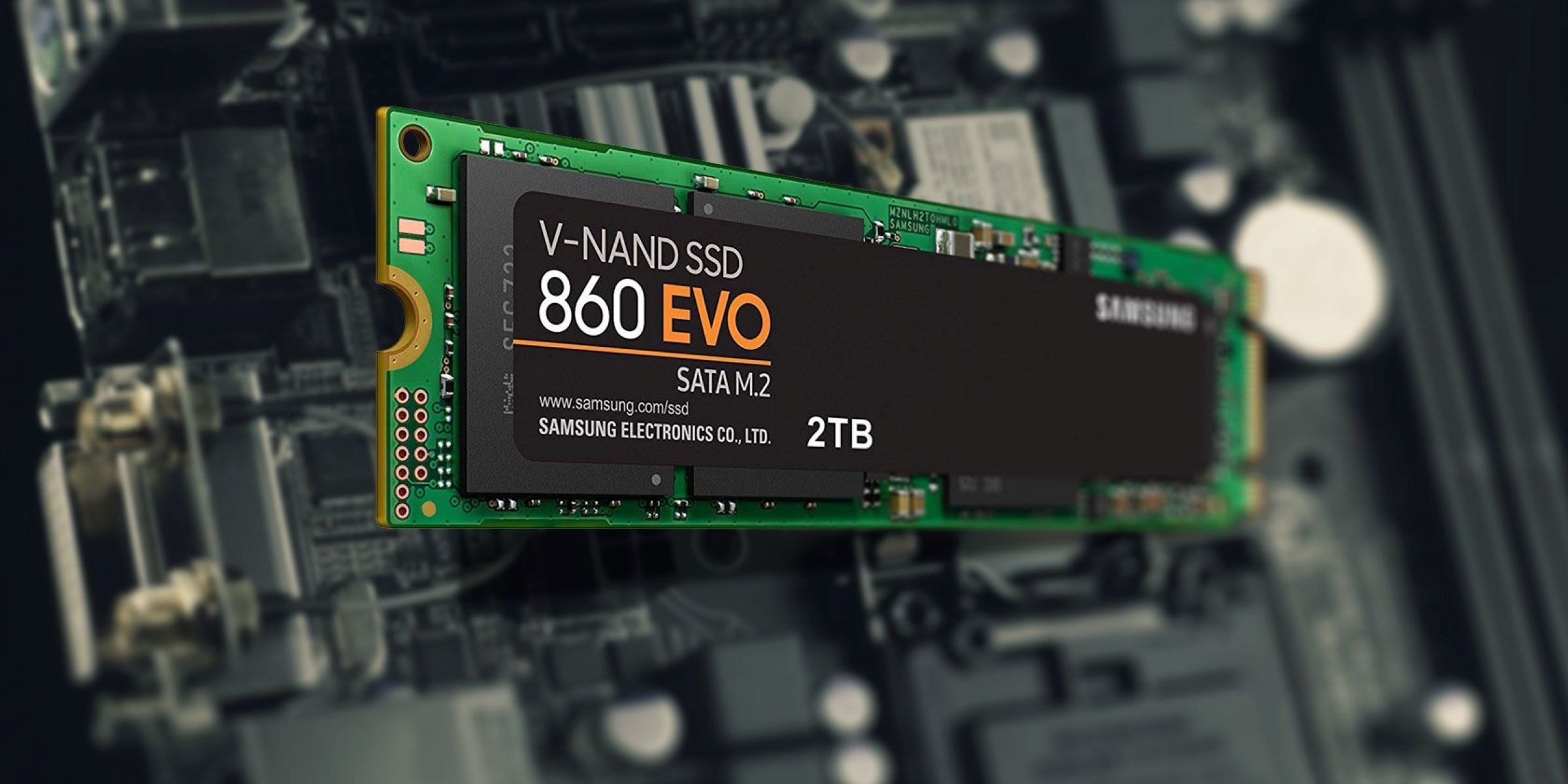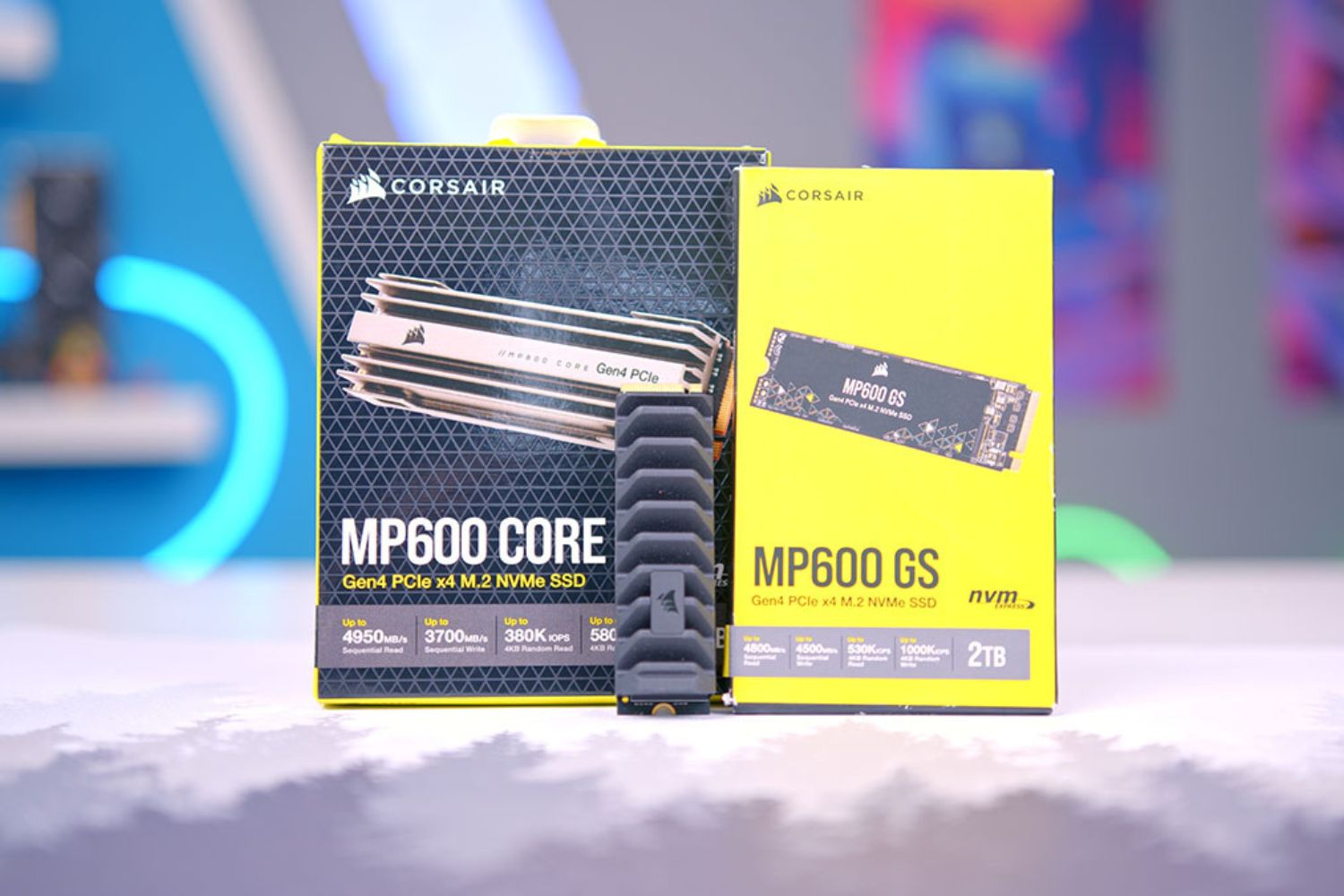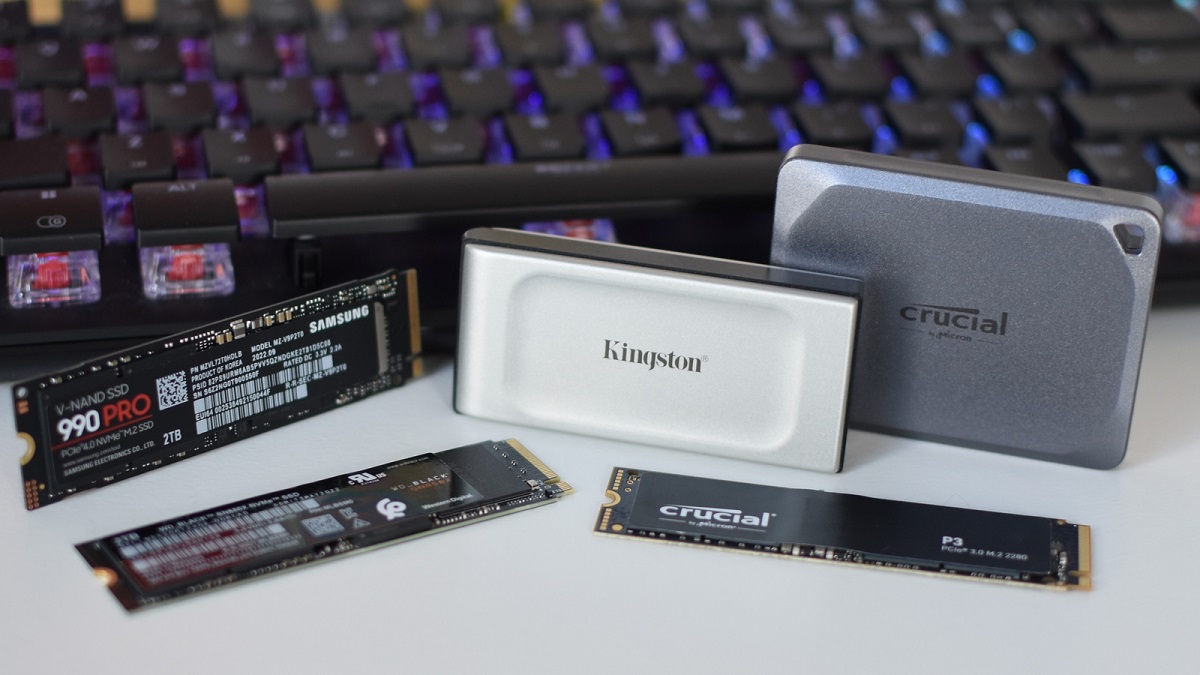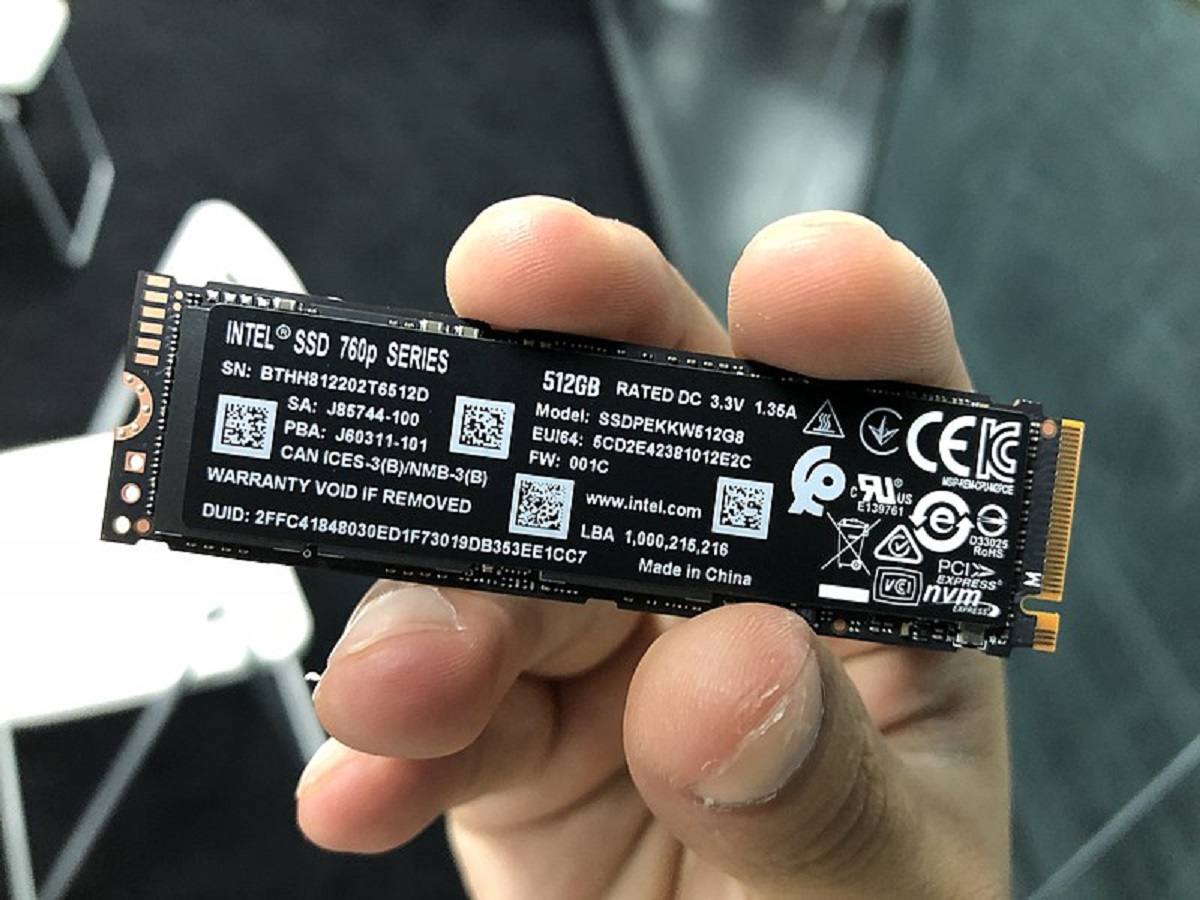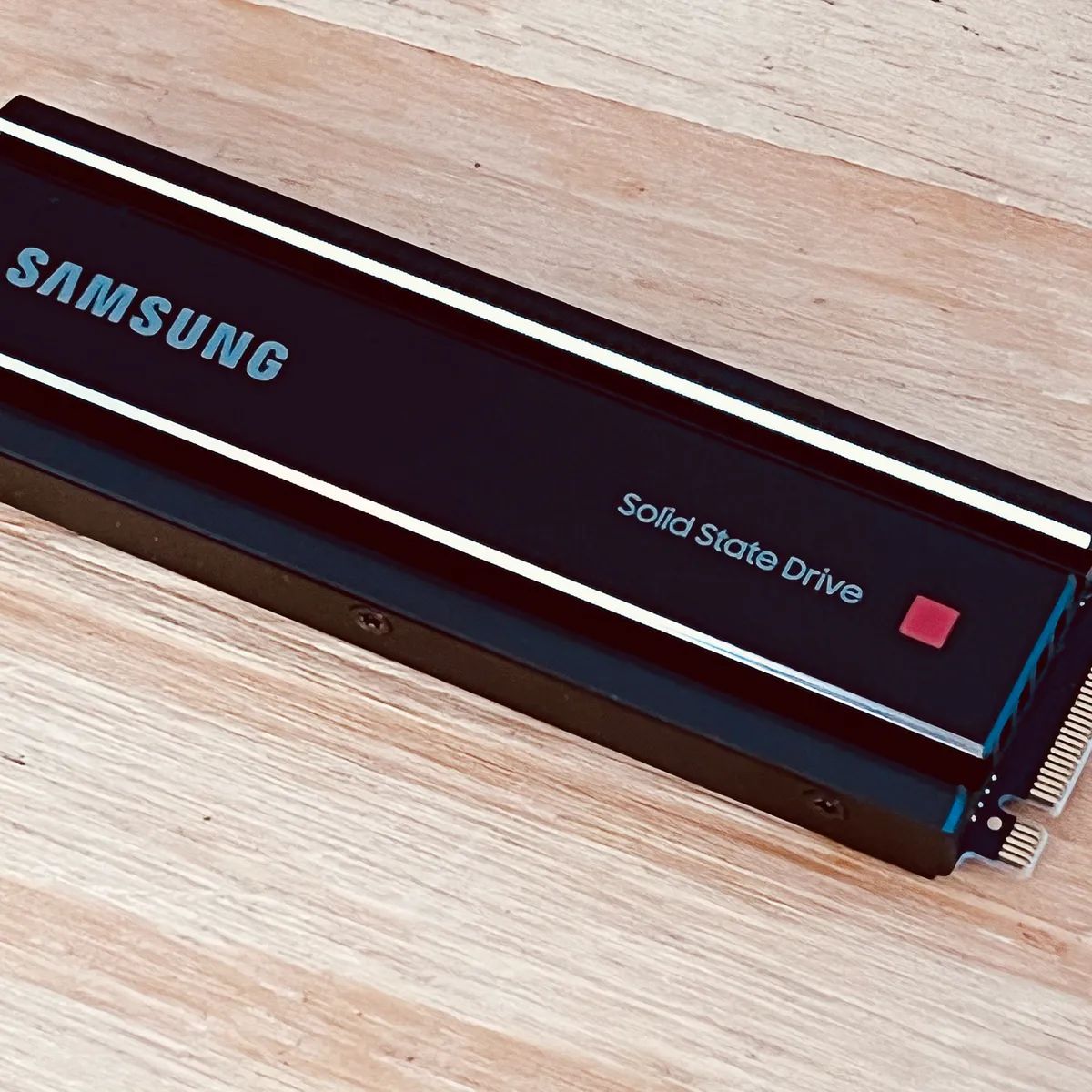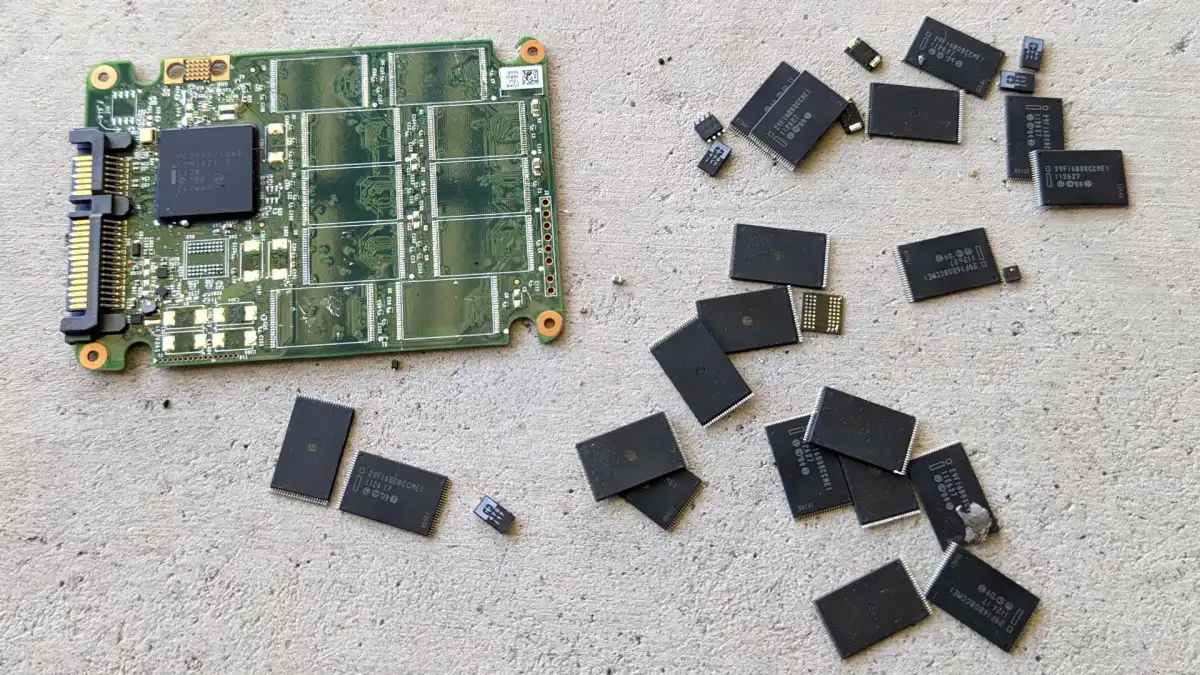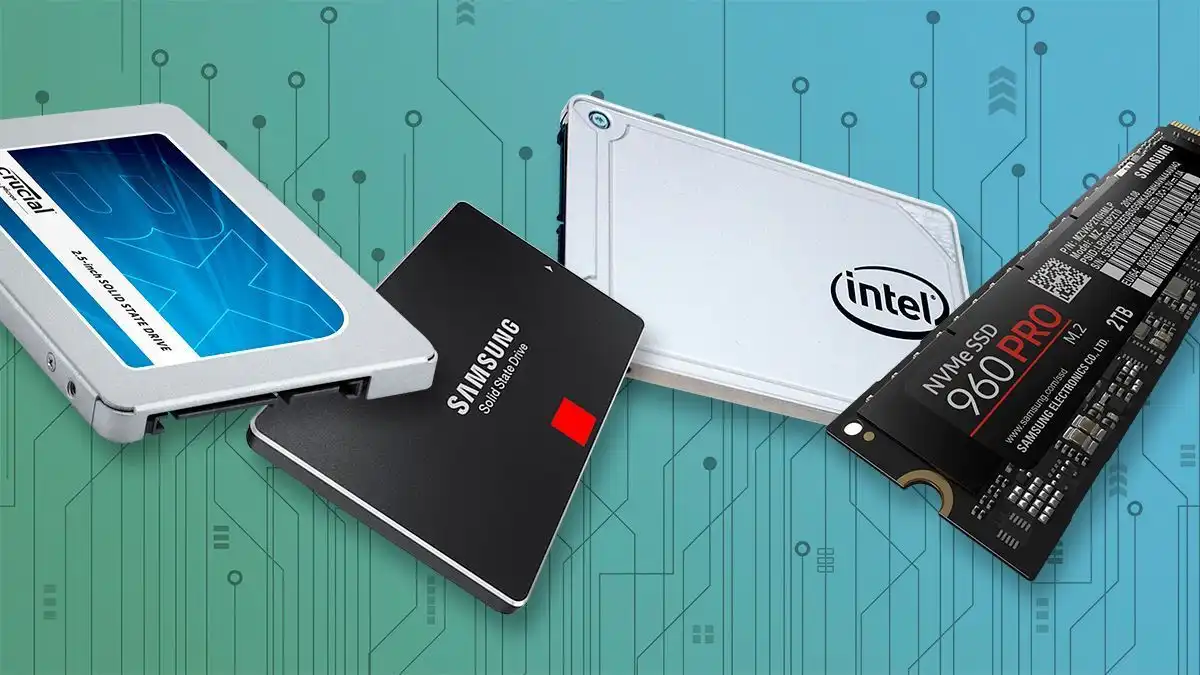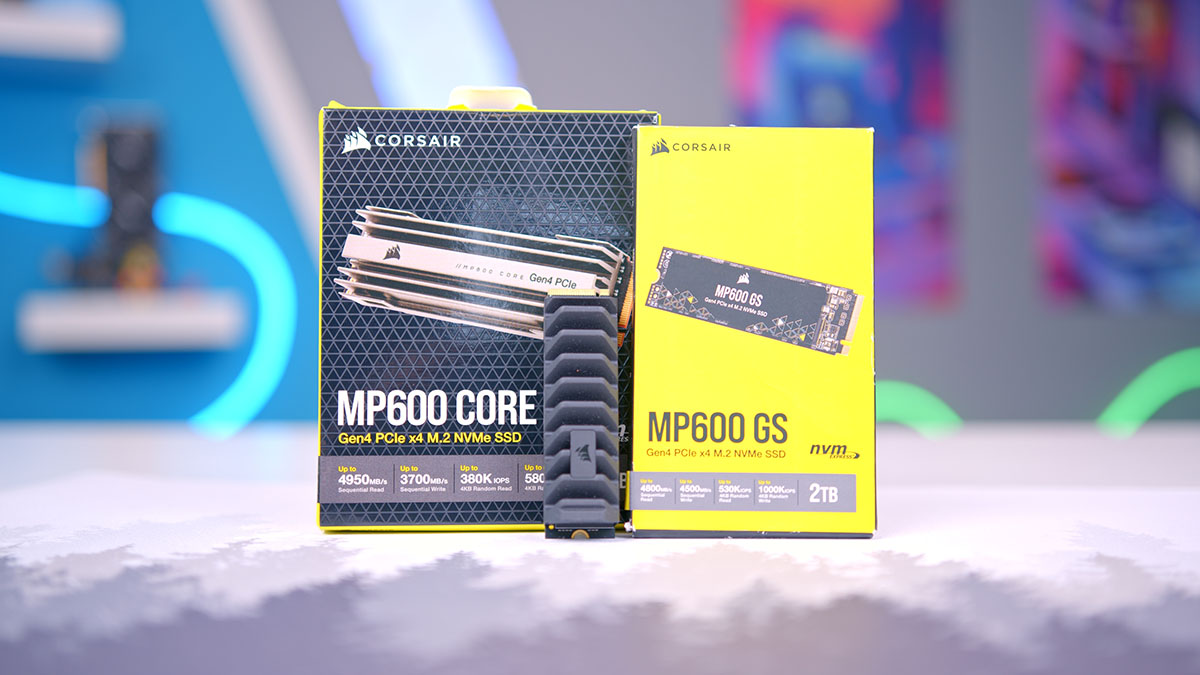Introduction
Welcome to this guide on how to install an Intel 660P M.2 2280 2TB NVMe PCIe 3.0 x4 3D NAND Internal SSD. If you’re looking to upgrade your computer’s storage capabilities and boost its performance, then you’ve come to the right place. The Intel 660P is a reliable and high-speed solid-state drive (SSD) that offers a significant improvement over traditional hard drives.
Before we dive into the installation process, it’s important to understand what exactly an NVMe SSD is and why the Intel 660P is a great choice for your storage needs.
An NVMe SSD, or non-volatile memory express solid-state drive, is a type of storage device that uses high-speed PCIe connections to deliver faster data transfer rates and reduced latency compared to traditional SATA-based SSDs. This makes NVMe SSDs ideal for applications that require fast read and write speeds, such as gaming, video editing, and complex data analysis.
Now, you might be wondering why we specifically recommend the Intel 660P M.2 2280 2TB NVMe PCIe 3.0 x4 3D NAND Internal SSD. Well, apart from its impressive specifications, the Intel 660P offers a great balance between performance, capacity, and affordability. With its large 2TB storage capacity and PCIe 3.0 x4 interface, this SSD delivers lightning-fast speeds for both sequential and random read/write operations, allowing you to transfer and access data quickly.
The Intel 660P also utilizes 3D NAND technology, which stacks memory cells vertically to increase storage density and improve overall performance and reliability. This means you can have peace of mind knowing that your data is stored securely and that your system will run smoothly with minimal lag or delays.
Before we get started with the installation process, there are a few things you need to consider and prepare. This includes gathering the necessary tools and materials, as well as ensuring your computer is ready for the upgrade. Once you have everything ready, we can proceed with the step-by-step installation process to get your new Intel 660P M.2 2280 2TB NVMe PCIe 3.0 x4 3D NAND Internal SSD up and running.
What is an NVMe SSD?
If you’re familiar with solid-state drives (SSDs), you may already know that they offer faster speeds and better performance compared to traditional hard disk drives (HDDs). But what exactly is an NVMe SSD, and how does it differ from other types of SSDs?
NVMe stands for non-volatile memory express, which is a communication protocol designed specifically for SSDs. It provides a more efficient way for the computer’s processor to communicate with the storage device, eliminating bottlenecks and maximizing performance.
One of the key advantages of NVMe SSDs is their incredible speed. Unlike SATA-based SSDs, which connect through the slower SATA interface, NVMe SSDs use the PCIe (Peripheral Component Interconnect Express) interface to achieve faster data transfer rates. PCIe offers higher bandwidth and lower latency, resulting in significantly reduced loading times and improved overall system responsiveness.
Another defining feature of NVMe SSDs is their form factor. While traditional SATA SSDs often come in the 2.5-inch drive form factor, NVMe SSDs typically come in the smaller M.2 form factor. This compact size enables easy installation in laptops, Ultrabooks, and compact desktop systems.
NVMe SSDs also offer superior performance when it comes to random read and write operations. These drives excel in handling multiple data requests simultaneously, which is particularly advantageous in tasks that involve heavy multitasking or working with large files.
Additionally, NVMe SSDs are known for their low power consumption and efficient power management. This is a significant benefit for mobile devices, as it helps to prolong battery life and reduce heat generation.
In terms of compatibility, it’s important to ensure that your motherboard supports NVMe SSDs before making a purchase. Most modern motherboards have at least one M.2 slot that supports NVMe SSDs. However, it’s always a good idea to check your motherboard’s specification or consult the manufacturer to confirm compatibility.
With the increasing demand for faster storage solutions, NVMe SSDs have become the go-to choice for gamers, content creators, and professionals who rely on fast and reliable storage for their work. The Intel 660P M.2 2280 2TB NVMe PCIe 3.0 x4 3D NAND Internal SSD is an excellent example of an NVMe SSD that offers impressive performance, high capacity, and affordability.
Now that you have a clear understanding of what an NVMe SSD is and why it’s an excellent choice, let’s move on to the installation process of the Intel 660P M.2 2280 2TB NVMe PCIe 3.0 x4 3D NAND Internal SSD.
Why choose the Intel 660P M.2 2280 2TB NVMe PCIe 3.0 x4 3D NAND Internal SSD?
When it comes to upgrading your computer’s storage, there are numerous options available in the market. However, the Intel 660P M.2 2280 2TB NVMe PCIe 3.0 x4 3D NAND Internal SSD stands out as a reliable and high-performance choice. Here are a few reasons why you should consider choosing this SSD for your storage needs.
1. Impressive Performance: The Intel 660P offers exceptional performance that surpasses traditional hard drives and even some SATA-based SSDs. With its PCIe 3.0 x4 interface, you can experience lightning-fast data transfer speeds, allowing you to load applications, transfer files, and boot up your system in a matter of seconds.
2. High Capacity: With a generous storage capacity of 2TB, the Intel 660P provides ample space to store all your important files, games, movies, and more. Whether you’re a gamer, content creator, or professional, this SSD ensures that you never run out of space and can enjoy seamless multitasking without worrying about storage limitations.
3. 3D NAND Technology: The Intel 660P utilizes 3D NAND flash memory technology, which stacks memory cells vertically to increase storage density. This not only enhances the overall performance of the SSD but also improves its endurance and reliability. You can trust that your data will be protected and your system will run smoothly with this advanced technology.
4. Cost-effective Option: The Intel 660P offers a great balance between performance and affordability. Compared to other NVMe SSDs in the market, the Intel 660P is priced competitively, making it a cost-effective choice for users looking to upgrade their storage capabilities without breaking the bank.
5. Easy Installation: Installing the Intel 660P M.2 2280 2TB NVMe PCIe 3.0 x4 3D NAND Internal SSD is a straightforward process. With its M.2 form factor, you can easily insert the SSD into the M.2 slot on your motherboard without the need for cables or additional power connections. This makes the installation hassle-free and convenient, even for users with limited technical knowledge.
6. Trusted Brand: Intel is a well-established and trusted brand in the technology industry. With a strong reputation for producing high-quality products, you can have confidence in the reliability and longevity of the Intel 660P SSD. Additionally, Intel provides excellent customer support, ensuring that any issues or concerns you may encounter are promptly addressed.
Overall, the Intel 660P M.2 2280 2TB NVMe PCIe 3.0 x4 3D NAND Internal SSD offers a compelling combination of performance, capacity, affordability, and ease of installation. Whether you’re a casual user or a power user, this SSD will undoubtedly enhance your computing experience and provide the storage capabilities you need.
Now that you understand why the Intel 660P is an excellent choice, let’s move on to the installation process to get your SSD up and running in no time.
Before You Begin
Before diving into the installation process of the Intel 660P M.2 2280 2TB NVMe PCIe 3.0 x4 3D NAND Internal SSD, there are a few important things you need to consider and prepare. By taking these steps beforehand, you can ensure a smooth and successful installation. Here’s what you need to do:
1. Check Compatibility: Verify that your motherboard supports M.2 NVMe SSDs and has an available M.2 slot. Most modern motherboards do support NVMe SSDs, but it’s always a good idea to double-check the specifications of your specific motherboard model.
2. Backup Your Data: It’s crucial to back up your important data before proceeding with any hardware installation. While the chances of data loss during the SSD installation are low, it’s always better to be safe than sorry. Create a backup of your files on an external storage device or using cloud-based services.
3. Gather the Necessary Tools and Materials: Make sure you have all the required tools and materials at hand to complete the installation smoothly. Here’s a checklist of what you may need:
- Screwdriver
- Anti-static wrist strap (optional but recommended)
- Intel 660P M.2 2280 2TB NVMe PCIe 3.0 x4 3D NAND Internal SSD
- User manual or installation guide provided with your motherboard
4. Prepare Your Workspace: Find a clean, well-lit, and static-free workspace to carry out the installation. This will minimize the risk of damaging any components and ensure a safe environment for the installation process.
5. Familiarize Yourself with the Motherboard Manual: Take some time to read through the motherboard manual and familiarize yourself with the layout and specifications. Make note of the specific M.2 slot that supports NVMe SSDs and any related instructions provided by the motherboard manufacturer.
6. Ground Yourself: Static electricity can damage sensitive electronic components. To prevent this, wear an anti-static wrist strap or periodically touch a grounded metal surface to discharge any static buildup from your body.
7. Allocate Sufficient Time: Installing an SSD can take anywhere from 15 minutes to an hour, depending on your level of experience and the complexity of your system. Set aside enough time to complete the installation without rushing or feeling pressured.
Following these preliminary steps will ensure that you are well-prepared for the installation process, minimize the risk of errors, and maximize the chances of a successful SSD upgrade. Now that you have everything in order, we can proceed to the step-by-step installation guide for the Intel 660P M.2 2280 2TB NVMe PCIe 3.0 x4 3D NAND Internal SSD.
Step 1: Gather the necessary tools and materials
Before beginning the installation of the Intel 660P M.2 2280 2TB NVMe PCIe 3.0 x4 3D NAND Internal SSD, it’s important to gather all the necessary tools and materials. Having these items ready will ensure a smooth and efficient installation process. Here’s a list of what you’ll need:
- Screwdriver: You’ll need a small screwdriver, preferably a Phillips-head screwdriver, to secure the SSD in place. Make sure the screwdriver fits the screws typically used for computer hardware.
- Anti-static wrist strap (optional but recommended): While not mandatory, using an anti-static wrist strap can help prevent electrostatic discharge (ESD) and protect sensitive components from potential damage. It’s especially useful if you’re working in a dry environment or handling the SSD on carpeted surfaces.
- Intel 660P M.2 2280 2TB NVMe PCIe 3.0 x4 3D NAND Internal SSD: Of course, you’ll need the Intel 660P NVMe SSD itself. Ensure that you have the correct model and capacity for your requirements.
- User manual or installation guide: Check the user manual or installation guide provided with your motherboard. It will contain valuable information regarding the M.2 slot placements, compatibility, and any specific instructions for the installation process. Familiarize yourself with this documentation before proceeding.
It’s essential to have all these tools and materials ready before you start the installation process. This will save you time and prevent any interruptions or delays during the installation.
Remember, if you’re using an anti-static wrist strap, connect one end to your wrist and the other end to an unpainted metal part of your computer case to help discharge any static electricity. This precaution will safeguard your components from potential ESD damage.
Once you have gathered all the necessary tools and materials and familiarized yourself with the motherboard documentation, you’re now ready to move on to the next step: preparing your computer.
Step 2: Preparing your computer
Before installing the Intel 660P M.2 2280 2TB NVMe PCIe 3.0 x4 3D NAND Internal SSD, it’s important to prepare your computer for the installation. Follow these steps to ensure a smooth and successful installation process:
1. Power off your computer: Shut down your computer and disconnect it from the power source. This will help prevent any accidental damage to your system and ensure your safety during the installation process.
2. Remove any peripherals: Unplug any external devices connected to your computer, such as USB drives, headphones, or printers. Keeping the system clear of peripherals will give you more space to work and reduce the risk of accidentally damaging any connected devices.
3. Ground yourself: Static electricity can damage sensitive computer components, so it’s essential to ground yourself before handling any internal parts. You can do this by wearing an anti-static wrist strap or by touching a grounded metal surface, such as the metal part of your computer case. This will discharge any built-up static electricity from your body.
4. Find a clean and well-lit workspace: Choose a clean, well-lit area to perform the installation. Make sure you have enough space to comfortably work on your computer without any obstacles. A clear workspace will help prevent accidental damage and make it easier to keep track of smaller components.
5. Open the computer case: Depending on your computer’s model and case design, you’ll need to remove the side panel or access panel to gain access to the internal components. Refer to your computer’s user manual or manufacturer’s instructions for guidance on how to open the case safely.
6. Check for available M.2 slots: Once the computer case is open, visually inspect the motherboard to locate the available M.2 slots. These slots may be labeled on the motherboard itself or mentioned in the user manual. Identify the M.2 slot that supports NVMe SSDs and note its placement for the installation.
7. Take note of any special instructions: Some motherboards may require specific steps or precautions for installing an M.2 SSD. Consult your motherboard’s user manual or installation guide to see if there are any specific guidelines you need to follow.
By preparing your computer before the installation, you ensure that everything is in order and minimize the risk of errors or complications. With the computer powered off, peripherals unplugged, and a clean workspace, you’re now ready to proceed to the next step: identifying the M.2 slot on your motherboard.
Step 3: Identify the M.2 slot on your motherboard
Before installing the Intel 660P M.2 2280 2TB NVMe PCIe 3.0 x4 3D NAND Internal SSD, it’s important to identify the M.2 slot on your motherboard. The M.2 slot is where the SSD will be connected, so locating it is crucial for a successful installation. Follow these steps to identify the M.2 slot:
1. Refer to the motherboard documentation: Consult your motherboard’s user manual or installation guide to find detailed information about the M.2 slot. Look for diagrams or labeled sections that indicate the location of the M.2 slot(s). Pay attention to any instructions or specifications related to NVMe SSD compatibility.
2. Visually inspect the motherboard: With the computer case open, visually examine the motherboard for the M.2 slot. It is typically a thin, rectangular slot that is longer than it is wide. The M.2 slot may be labeled with an “M” or “M.2” on the motherboard itself, and it is usually located near the CPU socket or the PCIe slots. Take note of its position for the next step.
3. Check the size and keying: M.2 slots come in different sizes and key configurations. The Intel 660P M.2 SSD uses the 2280 form factor, which means it is 22mm wide and 80mm long. Additionally, ensure that the M.2 slot on your motherboard supports the PCIe 3.0 x4 interface, which is required for the optimum performance of the Intel 660P SSD.
4. Verify compatibility: It’s important to ensure that the M.2 slot on your motherboard supports NVMe SSDs like the Intel 660P. Some motherboards may have M.2 slots that only support SATA-based SSDs. Verify that your specific M.2 slot is NVMe-compatible to get the full benefits of the Intel 660P SSD’s speed and performance.
5. Take notes or pictures: If necessary, take notes or pictures of the M.2 slot location and any relevant details for future reference. This will help you during the installation process and can be useful if you need to consult the documentation or seek assistance later on.
Identifying the M.2 slot on your motherboard is an essential step as it ensures that you connect the Intel 660P SSD to the correct slot for optimal performance. Now that you’ve located the M.2 slot, you’re ready to move on to the next step: opening the computer case to access the internal components.
Step 4: Open the computer case
Before installing the Intel 660P M.2 2280 2TB NVMe PCIe 3.0 x4 3D NAND Internal SSD, you need to open the computer case to access the internal components. Opening the case allows for a clear view of the motherboard, making it easier to install the SSD. Follow these steps to open the computer case:
1. Turn off your computer: Ensure that your computer is powered off by shutting it down properly from the operating system.
2. Unplug the power cable: To ensure your safety and prevent accidental electrical shock or damage, disconnect the power cable from the wall outlet or power supply unit. This step removes all power sources and ensures that the computer is completely powered off.
3. Ground yourself: Static electricity can damage sensitive electronic components. To protect your computer from electrostatic discharge (ESD), ground yourself by wearing an anti-static wrist strap or by touching a grounded metal surface, such as the metal part of the computer case.
4. Locate the screws or latches: Examine the computer case and look for the screws or latches that secure the side panel or access panel. These screws are usually located at the back or on the edges of the case. In some cases, the panel may also have latches that need to be released.
5. Remove the side panel or access panel: Use a screwdriver to remove the screws holding the side panel in place. If your case has latches, release them to open the access panel. Gently pull the side panel away from the case to remove it, exposing the internal components of the computer.
Note: The process of opening the computer case may vary depending on the specific case model and manufacturer. If you’re unsure of how to open your computer case, refer to the user manual or visit the manufacturer’s website for detailed instructions specific to your case model.
With the computer case open, you can now access the internal components, including the motherboard. In the next step, we will proceed with inserting the Intel 660P M.2 2280 2TB NVMe PCIe 3.0 x4 3D NAND Internal SSD into the M.2 slot on the motherboard.
Step 5: Insert the M.2 SSD into the slot
Now that the computer case is open and you have access to the internal components, it’s time to insert the Intel 660P M.2 2280 2TB NVMe PCIe 3.0 x4 3D NAND Internal SSD into the M.2 slot on your motherboard. Follow these steps to ensure a smooth and secure installation:
1. Locate the M.2 slot: Refer to the documentation or visually inspect the motherboard to find the M.2 slot. It is a small, rectangular slot typically labeled “M” or “M.2.” Pay attention to the keying and position of the slot.
2. Prepare the M.2 SSD: Remove the Intel 660P SSD from its packaging, handling it by the edges to avoid damaging the components. Take note of the gold connectors on the SSD, as these will come in contact with the M.2 slot.
3. Align the SSD: Align the notches on the SSD with the keying on the M.2 slot. The notches are located on the longer side of the SSD, ensuring proper orientation for insertion. Take care not to force the SSD into the slot if it doesn’t align easily.
4. Insert the SSD: Gently slide the Intel 660P SSD into the M.2 slot at a slight angle. Apply a moderate and even pressure until the SSD is fully inserted into the slot, making sure that it is firmly seated. Do not apply excessive force or bend the SSD during insertion.
5. Secure the SSD: Once the SSD is inserted into the slot, it should be held in place by friction or a retention mechanism. Some motherboards have a screw or latch to secure the SSD. If a screw is required, consult the motherboard documentation to identify the correct screw size and location. Use a screwdriver to secure the SSD in place, ensuring it is tightly fastened but not overly tightened.
6. Double-check the installation: After securing the SSD, recheck that it is fully inserted and properly aligned in the M.2 slot. Ensure the gold connectors on the SSD are fully in contact with the slot for proper connectivity.
By following these steps, you have successfully inserted the Intel 660P M.2 2280 2TB NVMe PCIe 3.0 x4 3D NAND Internal SSD into the M.2 slot on your motherboard. In the next step, we will secure the SSD with a screw, providing additional stability and ensuring a reliable connection.
Step 6: Secure the M.2 SSD with the screw
After inserting the Intel 660P M.2 2280 2TB NVMe PCIe 3.0 x4 3D NAND Internal SSD into the M.2 slot, it’s important to secure it in place to ensure a stable and reliable connection. Follow these steps to securely fasten the SSD using a screw:
1. Locate the screw hole: On the motherboard, near the M.2 slot, you will find a tiny screw hole designated for securing the SSD. This hole is typically labeled or indicated in the motherboard documentation. Take note of its position.
2. Prepare the screw: If your motherboard includes a screw specifically for M.2 SSD installation, use it to secure the SSD. If not, ensure you have a small screw that fits the screw hole. Take care not to use a screw that is too long, as it may damage the components or prevent proper installation.
3. Position the screw: Place the screw over the screw hole in the SSD and align it with the hole on the motherboard. Gently guide the screw into the hole, ensuring it is aligned properly and straight.
4. Tighten the screw: Use a screwdriver to tighten the screw until it is snug but avoid applying excessive force. It’s crucial not to overtighten the screw as it can damage the SSD or strip the screw hole.
5. Double-check the secure fit: After tightening the screw, verify that the Intel 660P SSD is securely fastened in the M.2 slot. Gently try to wiggle the SSD – it should be snug and firmly held in place. If there is any excessive movement, ensure the screw is adequately tightened.
6. Avoid over-tightening: It’s important to strike a balance when tightening the screw. Over-tightening can damage the components or result in a poor connection, while under-tightening may lead to an unstable SSD. Ensure the screw is appropriately tightened to provide a secure fit without excessive force.
By following these steps, you have successfully secured the Intel 660P M.2 2280 2TB NVMe PCIe 3.0 x4 3D NAND Internal SSD in place using a screw. This provides stability and ensures a reliable connection to the motherboard. In the next step, we will move on to closing the computer case and preparing for the system’s power-on.
Step 7: Close the computer case
Now that the Intel 660P M.2 2280 2TB NVMe PCIe 3.0 x4 3D NAND Internal SSD is securely installed and fastened inside the M.2 slot, it’s time to close the computer case. Follow these steps to ensure that the case is properly closed and secured:
1. Ensure all internal components are secure: Before closing the case, double-check that all other internal components are properly seated and secured. Verify that the cables are connected securely, RAM modules are in place, and any expansion cards are inserted correctly. This step ensures that nothing inside the computer is loose or at risk of getting dislodged during the case closure.
2. Align the case: Align the side panel or access panel in the correct position with the computer case. Ensure that the panel aligns with the screw holes or latches on the case.
3. Slide the panel into place: Gently slide the side panel or access panel back into position. Apply even pressure to ensure that it fits into the case properly. If there are screws, tighten them using a screwdriver until they are snug, but avoid overtightening.
4. Test the closure: Verify that the case is closed securely by giving it a gentle shake. If there is any movement or rattling, double-check that the side panel or access panel is properly aligned and firmly in place. Ensure that all screws are tightened evenly.
5. Connect the power cable: Plug in the power cable to the computer or the power supply unit, depending on your setup. This step is necessary for powering on the computer and testing the newly installed SSD.
6. Ground yourself: Before turning on the computer, ground yourself to discharge any static electricity. Use an anti-static wrist strap or touch a grounded metal surface to ensure the safety of both yourself and the computer components.
With the computer case closed and secure, you’re now ready to power on the computer and check if the Intel 660P M.2 2280 2TB NVMe PCIe 3.0 x4 3D NAND Internal SSD is properly detected by the system. In the next step, we will guide you through the process of powering on the computer and checking for detection of the newly installed SSD.
Step 8: Power on the computer and check if the M.2 SSD is detected
After closing the computer case, it’s time to power on the computer and ensure that the Intel 660P M.2 2280 2TB NVMe PCIe 3.0 x4 3D NAND Internal SSD is detected by the system. Here’s how to check if the SSD is properly recognized:
1. Connect the power cable: Plug in the power cable to the back of the computer or the power supply unit if it was disconnected during the installation process.
2. Press the power button: Locate the power button on your computer and press it to turn on the system. Wait for the computer to boot up and reach the operating system.
3. Access the BIOS/UEFI: During the initial startup, you may see a splash screen or a logo displayed. At this time, look for a key prompt, usually displayed as “Press [Key] to enter BIOS/UEFI.” Common keys to access the BIOS/UEFI include F2, Del, Esc, or F12. Press the corresponding key immediately when prompted to enter the BIOS/UEFI setup.
4. Locate the SSD in the BIOS/UEFI: Once you are in the BIOS/UEFI setup, navigate to the section that displays information about connected devices or storage configuration. Look for your Intel 660P M.2 SSD in the list of drives or storage devices. It should be listed with its correct capacity and model number.
5. Verify SSD detection: Ensure that the Intel 660P SSD is correctly recognized by the system. The SSD should be detected as a storage device and display its capacity. If you can see this information, it means that the computer has successfully detected the SSD.
6. Save and exit the BIOS/UEFI: If the SSD is properly detected, save any necessary changes made in the BIOS/UEFI setup (if applicable) and exit the setup. Your computer will then continue to boot into the operating system.
If the Intel 660P M.2 SSD is detected by the system and no errors or issues are reported, congratulations! You have successfully installed and recognized the SSD. You can now proceed with setting up the SSD for use, which includes formatting and initializing the drive as outlined in the next step.
Step 9: Format and initialize the M.2 SSD
Now that the Intel 660P M.2 2280 2TB NVMe PCIe 3.0 x4 3D NAND Internal SSD has been detected by the system, the final step is to format and initialize the SSD. This process prepares the SSD for use by creating a file system and allocating storage space. Follow these steps to format and initialize the SSD:
1. Open Disk Management: On Windows, right-click on the Start menu and select “Disk Management” from the context menu. This will open the Disk Management utility.
2. Locate the M.2 SSD: In Disk Management, you will see a list of drives connected to your system. Look for the Intel 660P SSD in the list. It might be labeled as “Unallocated” or “Raw”.
3. Format the SSD: Right-click on the unallocated space of the Intel 660P SSD and select “New Simple Volume”. Follow the prompts of the New Simple Volume Wizard to format the SSD with the desired file system (e.g., NTFS) and allocation unit size. You can choose the default settings unless you have specific requirements.
4. Assign a drive letter: After formatting, the SSD will be assigned a drive letter. You can select the desired drive letter or let the system assign one automatically.
5. Initialize the SSD: If the Disk Management utility prompts you to initialize the disk, select the default partition style (usually GPT) and proceed. This will initialize the SSD for use within the operating system.
6. Complete the process: Follow the remaining prompts of the wizard to complete the formatting and initialization process. Once finished, the Intel 660P SSD will be ready for use.
Note: The formatting and initialization process may vary slightly depending on the operating system you’re using. However, the general steps are similar across most versions of Windows.
After completing these steps, you have successfully formatted and initialized the Intel 660P M.2 2280 2TB NVMe PCIe 3.0 x4 3D NAND Internal SSD. It is now ready to be used for storing files, running applications, and improving the performance of your computer.
Conclusion
Congratulations! You have successfully installed the Intel 660P M.2 2280 2TB NVMe PCIe 3.0 x4 3D NAND Internal SSD into your computer. By following the step-by-step guide, you have upgraded your computer’s storage capabilities, improved system performance, and gained the benefits of faster data transfer rates.
The Intel 660P SSD, with its impressive speed, high capacity, and affordability, provides an excellent storage solution for various needs, including gaming, content creation, and professional work. With its 3D NAND technology and PCIe 3.0 x4 interface, you can enjoy lightning-fast read and write speeds while keeping your data secure and your system running smoothly.
Remember to always back up your important data before making any hardware changes to your computer. This ensures that your data is protected and can be easily recovered if needed.
Whether you’re a casual user or a power user, the installation and setup process for the Intel 660P SSD is a great way to enhance your computing experience. Now that you have completed the installation and the necessary formatting and initialization, you can fully enjoy the improved performance and storage capacity offered by your new SSD.
If you have any questions or encounter any issues during the installation process, make sure to consult the user manual or reach out to the manufacturer’s support for assistance. They will be able to provide you with the necessary guidance and troubleshooting steps.
Thank you for choosing the Intel 660P M.2 2280 2TB NVMe PCIe 3.0 x4 3D NAND Internal SSD. Enjoy your enhanced storage capabilities and improved computer performance!







